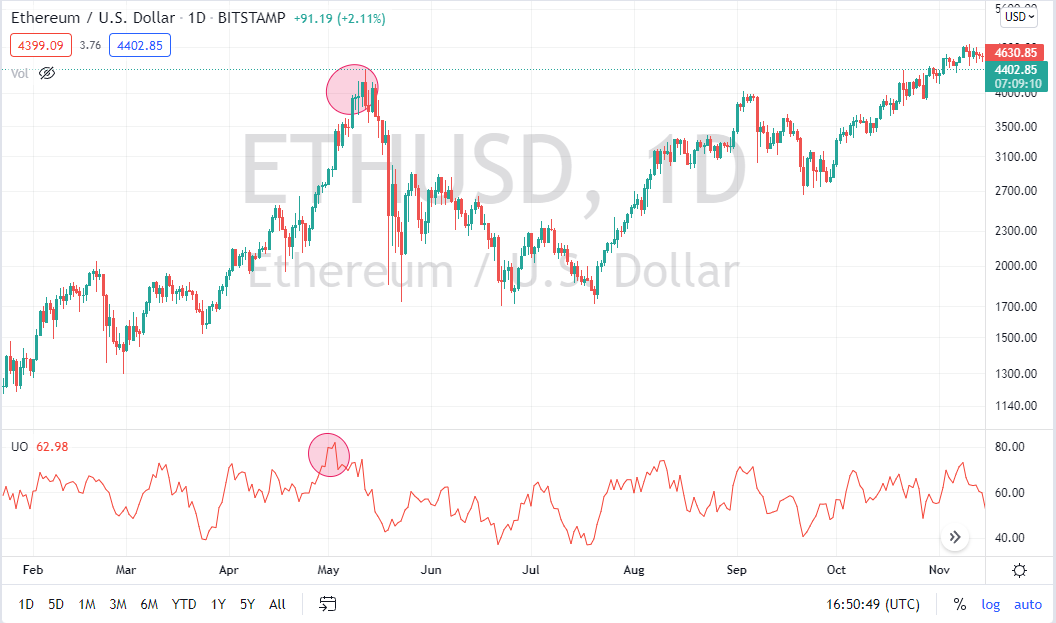What is the Ultimate Oscillator? Definition
Top Forex Brokers
The ultimate oscillator is an indicator that was developed by Larry Williams in the mid-1970s to measure the pricing momentum of a stock or commodity via multiple time frames. Since then, it has been applied to other markets, as it tends to be less volatile and produce fewer signals, and therefore generates fewer whipsaws than many other similar indicators.
Signals are generated via divergences, and as they are generated on multiple time frames, it takes much more to create a signal from this indicator than most of the similar ones you may be used to using.
The ultimate oscillator is an indicator that has its own window on the chart, like any other oscillator. It also oscillates between two major levels, 0 and 100, like many other oscillators. Readings below the 30 level indicate an oversold situation, while readings above 70 indicate the price as overbought. Like many other oscillators, traders can use divergence between the signal and price action on the chart to identify a trade entry signal. In other words, when price moves in the opposite direction of the indicator, it shows that a trade could be setting up.
One of the things that makes the ultimate oscillator so different from other oscillators such as the MACD indicator, the stochastic oscillator, and many others is the fact that it uses multiple time frames to smooth out values. It then claims to be a more reliable indicator of momentum, offering fewer false signals. The ultimate oscillator timeframes measure advanced momentum by including a short, medium, and long period.
- Short time period – 7 days
- Medium time period – 14 days
- Long time period – 28 days
By using these three different price periods, all three need to line up in the same direction and tell the same thing to produce a trade signal. This helps filter out the noise of unimportant day-to-day price movement.
Ultimate Oscillator Formula and Calculation
If you will use the ultimate oscillator indicator, your charting software will be managing the output for you and performing the calculations required to generate the output readings, so you don’t really need to know the formula and calculation, so feel free to skip to the next section of this article if you want. However, it can be useful to understand how any indicator is calculated as you can better understand what its output truly shows.
The calculation used by the ultimate oscillator indicator is quite complicated, and is detailed below:
- We begin by calculating the Buying Pressure (BP), which is the overall direction of the price action. BP measures the current close compared to the existing prior close or which is the lowest: recording the values over the 7-, 14- and 28-day timeframes. This generates the BP Sum.
BP = Close - Minimum (Low or Prior Close)
- We then calculate the True Range (TR), which measures the current highest price range to the prior close to the recent low or previous close: recording the values over the 7-, 14- and 28-day timeframes. This generates TR Sum, telling us the magnitude of gain or loss in the market.
TR = Maximum (High or Prior Close) - Minimum (Low or Prior Close)
- We then find the average of the 7-, 14- and 28-day periods, using the previous BP and TR calculations. Then, adding together the sums of each day, for example, the average 14-day BP sum is the values over the 14-period added together.
Average7 = (7-period BP Sum) / (7-period TR Sum)
Average14 = (14-period BP Sum) / (14-period TR Sum)
Average28 = (28-period BP Sum) / (28-period TR Sum)
- Finally, we calculate the Ultimate Oscillator (UO) using the average 7-, 14- and 28-day values. The different average time frames have different weightings, with greater weight given to the average over the most recent days. For example, an average 7 has a weight of 4, an average 14 has a weight of 2, and an average of 28 has a weight of one. We then add the products together to get the Ultimate Oscillator output, which is always a value between 0 and 100.
UO = 100 x / (4+2+1)
The Difference Between the Ultimate Oscillator and Stochastic Oscillator
Most traders would agree that the main choice of oscillator indicators is between the three timeframe ultimate oscillator, or the more common single timeframe stochastic oscillator. The ultimate oscillator uses a 3-timeframe system and a three-step method for trading divergence but does not typically include a signal line. On the other hand, the stochastic oscillator covers a single timeframe and signal line. Both oscillators create trade signals based on divergence, but due to the different time frames, these signals will vary between the two oscillators. Each oscillator has pros and cons:
- The single timeframe stochastic oscillator is often favored over the ultimate oscillator in a ranging market because the stochastic oscillator is simpler to understand and can have a higher degree of accuracy when generating overbought and oversold trading signals.
- While the stochastic oscillator is excellent for rangebound markets, the ultimate oscillator can produce signals in both rangebound and trending markets, although it should be noted that trending markets are almost always when you see signals. The stochastic oscillator performs miserably in a trending market, thereby making it a very specialized indicator.
- The ultimate oscillator has the advantage of being widely considered to be more accurate in monitoring divergences in market trends over different periods, compared to the stochastic oscillator.
How to Use the Ultimate Oscillator to Generate Buy & Sell Signals
When using the ultimate oscillator, Larry Williams had precise criteria for the buy and sell signals.
The ultimate oscillator is a remarkable technical analysis tool when looking for stocks to buy or sell. And when setting it up, there are several things to look out for.
First, with 50 being the centerline, we must look out for trends above 60, an overbought position of below 30, and an oversold position.
Buy Signal
- Entry - For a buy signal, look out for overbought signals below 30 on the advanced. Here we look for a bullish divergence, for example, when the divergence makes a new low, but the UO makes a higher low.
- Exit – When you are looking for an exit or selling an asset or stock,y ou can take a risk and exit at 50, or play it safer and exit at 30.
Sell Signal
- Entry – For a sell signal, the ultimate oscillator must have reached 70, or shown bearish divergence (this is when the price makes a new high, but the oscillator makes a lower high).
- Exit – A good place to cash the asset or stock is to wait for the ultimate oscillator to reach 50, or above the 70 mark on the advanced.
Ultimate Oscillator Strategy Examples
In the price chart shown below this paragraph, you can see that I have a couple of circles on the USD/CAD daily chart. Note that the ultimate oscillator had reached a reading of 20 in early May. Notice that the indicator then started to rise from the bottom, from 20, while the price continued to fall. This is what is known as a divergence (when an oscillator moves in the opposite direction of the price). This often signals an impending reversal. As the market started to turn around, the oscillator continues to go higher. The buy signal was created 2 weeks ahead of a major breakout. This is a great “heads up” as to something changing in the market’s structure. Usually, I will use this indicator to give me trading ideas and then wait for some type of breakout as confirmation. You can see clearly that we had broken above the 1.2150 level just a few days after bottoming, and then rallied all the way to the 1.29 handle over the next couple of months.

Ultimate Oscillator Buy Signal
In the second example presented in the below price chart, you can see that Ethereum had been in a very strong run between the months of April and May. Notice the circle in the ultimate oscillator window, as the oscillator peaked above the 80 level very briefly, and then started to fall. Notice that Ethereum continued to rise over the next couple of days. This was another “heads up” type of sell signal that this indicator is known for. This is a perfect example of a signal to take profits had you already been participating in the long-term run higher.
Shortly after the ultimate oscillator broke back down, Ethereum dropped by over 50%. At the very least, this should have had you tightening up stops as soon as you saw the divergence between the oscillator and price, saving you massive potential losses.

Ultimate Oscillator Sell Signal
The ultimate oscillator is probably suited best to longer-term time frames such as the weekly, daily, and maybe 4-hour charts. Traders looking at shorter-term charts might find the stochastic oscillator more suited to generating appropriate buy and sell signals.
Final Thoughts
The ultimate oscillator is a handy tool to find divergence in the market. If you are somebody who uses MACD, RSI, or CCI for divergence signals, you will likely find this indicator useful in your trading. It will be a natural fit, as it shows quite clearly what you are looking for in those oscillators. However, if you are a short-term trader, it probably will not do you much good, because shorter-term traders need quicker signals.
The ultimate oscillator does at well at keeping you out of trouble during rangebound markets, and it is also a great tool to find good exits to longer-term trades. If you choose to only follow the longer-term trend, you need something to tell you when it is time to take profits and wait for a pullback. The ultimate oscillator is great at doing this.
One major issue with the ultimate oscillator is that it is not always included as a preset within all trading platforms, so you may have to find it somewhere. Nonetheless, there are many free add-ons available out there that allow you to customize your terminal.
If you are interested in further reading about oscillators, check out our articles about the Relative Strength Indicator and the Forex Detrended Price Oscillator. You can also learn more about technical analysis concepts such as momentum, volatility, and volume.
For all the basics on how to trade Forex, our introduction to Forex trading will be useful.
Also, take a look at our guides to the best Forex brokers, CFD trading brokers, and commodity trading brokers.
FAQs
How does the ultimate oscillator work?
The ultimate oscillator calculates buying pressure on three different time frames based upon recent price action, then produces a smoothed weighed average which can be used to indicate whether an asset is overbought or oversold.
What is the purpose of an oscillator?
On oscillator is a technical indicator which produces a signal to indicate whether a particular asset is oversold or overbought, meaning that the price is over-extended from its average and prone to snap back to it. Oscillators can also be used to measure momentum.
How do you trade with the ultimate oscillator?
In Forex and CFD trading, the ultimate oscillator is usually most effective when applied to the daily time frame. When the price is oversold but price action looks bullish, you have a long entry signal, and vice versa.
